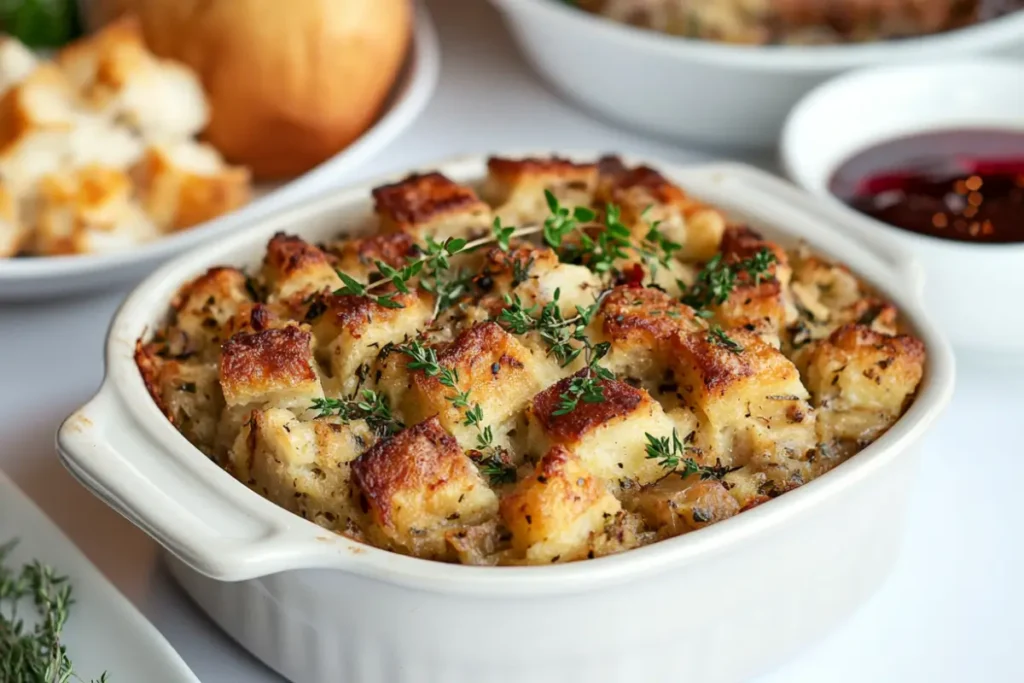Getting the right moisture in your dressing is key for a tasty meal. You can try a classic chicken dressing or a cornbread dressing with chicken. But How moist should dressing be before baking?.
Whether you’re an experienced baker or new to it, getting the moisture right is important. A balanced dressing recipe can make a big difference in taste and texture. By following some simple tips, you can make a delicious chicken and dressing that will wow everyone.
Table of Contents
Key Takeaways
- Understanding the importance of moisture content is crucial for a delicious dressing
- Achieving the perfect balance of moisture will elevate your chicken and dressing
- A well-balanced chicken dressing recipe is essential for flavor and texture
- Mastering the ideal moisture level will ensure your dressing turns out perfectly every time
- A classic chicken dressing recipe or cornbread dressing with chicken can be perfected with the right moisture level
- Following simple guidelines can help you create a mouth-watering chicken and dressing
Understanding the Basics of Dressing Moisture

Making a tasty cornbread dressing with chicken means getting the moisture just right. You want it moist and full of flavor, not dry. To achieve this, you need to grasp the basics of dressing moisture.
This includes why moisture is important, the science behind it, and the right moisture ratios. Knowing these will help you make a moist and savory dressing.
As you start making your homemade chicken and dressing, finding the right balance is key. You need to mix the right bread, veggies, and liquids. This balance will give you a moist and tasty side dish that goes well with many meals.
Why Moisture Level Matters
The moisture in your dressing greatly affects its texture and taste. If it’s too dry, it’s unpleasant. If it’s too wet, it’s soggy. The right moisture ratio makes your dressing flavorful and textured.
The Science Behind Perfect Dressing
Understanding how ingredients work together is crucial for perfect dressing. You need to know how bread absorbs liquid and how veggies release moisture. Seasonings also play a big role in enhancing flavor. By grasping these interactions, you can make a dressing that’s both delicious and moist.
How Moist Should Dressing Be Before Baking?
Getting the right moisture in your dressing is key when baking. Whether it’s a classic chicken and dressing or something more complex, the moisture affects the taste and texture.
Think about the ingredients you’re using to find the perfect moisture. Dry bread might need more liquid, while fresh herbs might need less to avoid sogginess.
Here are some tips to help you get it just right:
- Use a mix of wet and dry ingredients for the right balance.
- Avoid overmixing to prevent a dense, dry dressing.
- Check the dressing’s internal temperature with a thermometer. It should be 165°F (74°C) for safety.
By following these tips and using your judgment, you can make a moist and tasty chicken and dressing. It’s sure to be a hit with everyone.
Essential Ingredients That Affect Moisture Content
Choosing the right ingredients is key to a moist cornbread dressing with cream chicken soup. You want it to be just right, not too wet or dry. Knowing how each ingredient impacts moisture is important.
The bread and cornbread you pick matter a lot. The type of bread, like white or whole wheat, changes the moisture. Cornbread adds flavor and texture, making it rich with cream chicken soup.
Bread and Cornbread Components
Here are some key factors to consider when selecting bread and cornbread components:
- Type of bread: white, whole wheat, or a combination
- Cornbread ratio: how much cornbread to use in relation to the bread
- Moisture content: how the bread and cornbread affect the overall moisture level
Read More:
Cornbread dressing with cream chicken soup: A simple recipe
Liquid Ingredients Selection
Liquid ingredients like cream chicken soup, broth, or stock are also crucial. The right amount and type can make or break your dressing. Too much soup makes it wet, too little makes it dry.
| Ingredient | Moisture Content | Flavor Profile |
|---|---|---|
| Cream Chicken Soup | High | Rich and Savory |
| Broth or Stock | Medium | Mild and Neutral |
Understanding how ingredients affect moisture lets you make a moist cornbread dressing. It’s sure to be a hit.
Testing Your Dressing Consistency
When making homemade chicken and dressing, checking the dressing’s consistency is key. You can do this with a simple squeeze test. Just scoop up some dressing and squeeze it gently in your hand. If it holds its shape, it’s good to go.
If it’s too dry, add a bit more liquid. If it’s too wet, add more bread or cornbread. This will help you get it just right.
Here are some tips to improve your dressing’s consistency:
- Use the right ratio of liquid to dry ingredients. A good rule is 1/4 cup of liquid for every 2 cups of dry ingredients.
- Avoid overmixing the dressing. This can make it dense and dry.
- Let the dressing rest for a few minutes before baking. This lets the flavors mix and the bread soak up the liquid.
By following these tips and testing your dressing, you’ll make perfect homemade chicken and dressing every time. Adjust the ingredients to fit your taste and the type of dressing you’re making.
| Ingredient | Ratio | Description |
|---|---|---|
| Bread | 2 cups | Dry bread, cubed or torn into small pieces |
| Liquid | 1/4 cup | Chicken broth, stock, or other liquid ingredient |
| Vegetables and Herbs | 1/2 cup | Chopped onions, celery, and herbs like sage or thyme |
Common Moisture-Related Problems and Solutions
When making chicken dressing, you might face moisture issues. These problems can be annoying, but there are easy fixes. Knowing what causes these problems helps you avoid them and get the right moisture in your dressing.
To fix a dry dressing, add a bit of chicken broth or melted butter. If it’s too wet, add more bread or crackers to soak up the extra moisture. Finding the right balance is key to a great chicken dressing.
Too Dry: Fixing and Prevention
- Check the bread: If the bread is too dry, it can absorb too much moisture from the other ingredients.
- Add moisture: Try adding some chicken broth or melted butter to increase the moisture content.
- Adjust the cooking time: If the dressing is cooking too long, it can dry out. Try reducing the cooking time to prevent this.
Too Wet: Restoration Tips
- Add some absorbency: Try adding some extra bread or crackers to absorb the excess moisture.
- Reduce the liquid: If there’s too much liquid in the recipe, try reducing the amount of chicken broth or other liquids.
- Cook it longer: If the dressing is too wet, try cooking it for a longer period to evaporate some of the excess moisture.
By following these tips and adjusting your chicken dressing recipe, you can achieve the perfect moisture level and enjoy a delicious, homemade dressing.
Conclusion: Mastering Your Dressing Moisture Every Time
Getting the right moisture in your dressing is an art that needs practice. But with the right techniques, you can do it every time. This guide will help you make delicious and moist dressings, whether it’s classic chicken and dressing or cornbread dressing with chicken.
Understanding the science behind dressing moisture is key. Knowing how different ingredients affect the consistency is crucial. By testing your dressing and fixing any issues, you’ll learn what makes it perfect. The ideal dressing is moist but not soggy, letting the flavors stand out.
Now you have the skills to elevate your dressing game. Try new recipes, adjust ingredient ratios, and enjoy perfecting your own dressing. Making moist and flavorful dressing is essential for many favorite dishes. Master this skill, and you’ll be the star of every gathering.
FAQ
What is the ideal moisture level for dressing?
The right moisture level is key for a great dressing. It should be moist and tender, but not soggy.
How do I test the consistency of my dressing before baking?
To check your dressing’s consistency, try squeezing a small amount. It should hold its shape well, not too dry or wet.
What ingredients affect the moisture content of dressing?
Moisture in dressing comes from bread, cornbread, liquids, and veggies. Finding the right balance is important for the perfect moisture.
How can I fix a dressing that’s too dry?
For a dry dressing, add more broth or milk. Mix it gently until it’s just right.
What should I do if my dressing is too wet?
If it’s too wet, bake it longer to dry it out a bit. You can also add more bread to soak up the extra moisture.

